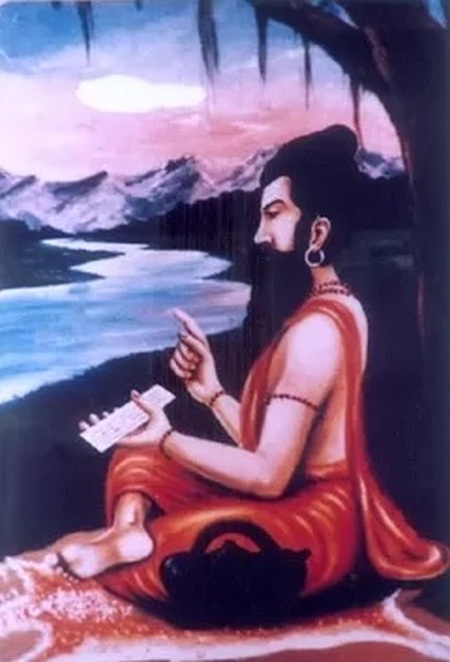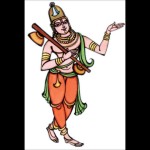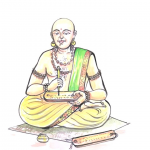The great Dharmic personages of Andhra are often given minimal coverage. Perhaps the first of these momentous mahanubhaavas is Baudhayana.
Continuing our Series on Andhra Personalities, is the earliest in our Set on Dharmic Personalities. He is none other than the famed author of the eponymous Dharmasutra.
Background
Backgrounds and aspects of regional origin are often controversial within India. The same degree of westphalian politics linking region-language-state-caste simply was not there in previous eras. Though regional politics certainly did exist, they generally took place upon substratum of Dharma & common Sanskritic Indic culture.
While love for language is very important, love for Dharma must be even greater. This is because language detached from Dharmic culture can then play host to any alien culture. Rather than the spirit of who we really are being reflected, what makes Andhra truly Andhra will be lost. It would result in an asuric spirit merely speaking the language of the Andhras rather than that of the descendant of Chandra Deva. What in fact made him Andhra Nripathi was establishing the Dharma of the devas in the desa named after him.
That is the importance of Baudhayana Muni. While different regions naturally wish to associate themselves with the prestige of various Rishis, it is also critical that history hew to the truth. It is only after careful evidence could be adduced that we now assert that Baudhayana was himself an Andhra Brahmin. We have it on the authority of an astika adhyatmika one himself (Pandit Kota Venkatachalam)
As such, Baudhayana Muni, the author of the famous Kalpasutra corpus is himself the son of the author of what is likely the first Andha Grammar: Kanva Andhra Vyakaranamu.
This may come as a disappointment to Nannaya Bhatta bandhuvulu, but rather than Andhra Sabda Chinthaamani being the first grammar, there were preceding ones as well.
What’s more, whether one can claim him as an Andhra or not, the father of Baudhayana, Maharishi Kanva, himself features significantly in our Puranas and Kavyas.
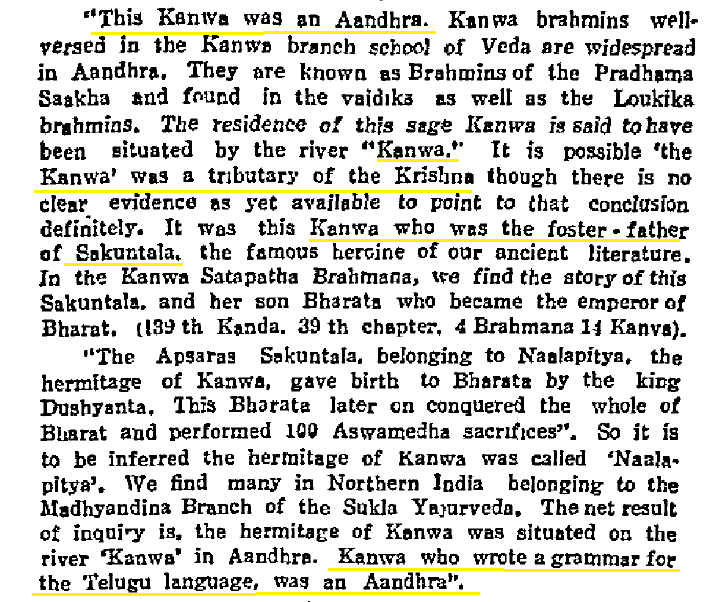
Not much else is known about the great muni Baudhayana. But his contribution lives on in the texts from which we know him best: the Kalpasutras.
His gotra is naturally Kanva, and he belongs to the Pradhama Sakha of Andhra Brahmins who follow Shukla Yajur Veda. However, the Kalpasutras themselves are classified under the Taittiriya Sakha of the Krishna Yajur Veda. Though the Western Historical paradigm dates him back to 800 BCE, Baudhayana is likely much older. While there are those who assert that he was merely born into the lineage of Kanva (who dates back to the Dvapara Yuga), when considering our Sastras as a whole, his being the actual son of Kanva actually makes sense.
The Kalpasutra corpus left behind by the son of Kanva maharshi remains influential to this day. While he is better known today for the Baudhayana theorem, this scholar and Acharya’s real impact is in the realm of Dharma. To understand why it is an accomplishment, one must take a closer look.
Achievements
Pythagoras theorem by Baudhaayan, in a form of Sanskrit Shloka (stanza) – pic.twitter.com/iPQTO5mIcV
— Vedic School (@SchoolVedic) June 14, 2014
Without a doubt, Baudhayana muni is notable for his comprehensive work on Dharma. His eponymous Dharmasutra is part of a larger corpus. It is attached to the Grhyasutra and ultimately the Kalpasutra of the same name. [3, 3]
Kalpasutras are expositions on ritual. They consist of Srautasutra (focused on yagna, i.e. sacrifice) as well as Grhyasutra (domestic rituals). Dharmasutras are part of Grhyasutras, and therefore we see how extensive his imprint is.
- Compiled the Baudhayana Kalpasutra (consisting of Srauta, Grhya, Sulba, & Dharma)
- 279 verses in his Dharmasutra [3,7]. He is known as a sutrakaara & vrttikaara.
- Credited with Baudhayana Vrtti, a commentary on the Brahma Sutra, which is part of the prasthana trayi (Brahma Sutra, Upanishads, Bhagavad Gita). Only part of the Vrtti remains.
- Baudhayana Theorem. This is considered an earlier statement of the Pythagorean theorem.
Ganita comes with strings attached, but no compass box 🙂 Constructing a square with a string & pins. pic.twitter.com/uMkHncmJ4m
— Shivoham (@Ganitamrita) December 4, 2014
Recently, Baudhayana has been noted for his contributions to mathematics. Though this is undeniable, it is best to understand his significance through the eyes of the tradition itself.
The Kalpasutra is divided into books called prasnas (questions) . The first 29 books pertain to the Srautasutra, book 30 deals with the Sulba Sutra (referring to Vedic Geometry}, with the next four books on Grhyasutra, and the final four on Dharmasutra. This makes a total of 38 books in the Baudhayana Kalpasutra. [3, 191]
In our difficult era of degraded behaviour, declining values, and divorce, Baudhayana muni gave us laconic wisdom that remains profound in its effect. It is food for thought for all those wondering why their bollywood romance isn’t working out or why their kids are such maligning malcontents:
Yathaa yuktho vivaahasthathha yuktha prajaa bhavatheethi vignayathe || 1.21.1
The excellence of the marriage, it is stated, determines the excellence of the children that issue from it. [3, 237]
If the values of society are to be rebuilt, it is on the foundation of such principles brought forth by Baudhayana of Andhra.
Legacy
That the life and legacy of Baudhayana muni is not only foundational but even defining to not only Andhras but all of Bharatavarsha is beyond a doubt. To this day, his dharmasutra determines the practice of Dharma in many households of the North.
In Andhra itself his Dharmasutra, has been replaced by another statesman, who will be discussed next. Nevertheless, his impact remains of tremendous import not only in the orthodox realm of ritual, yagna, and dharma, but also in mathematics (Ganita).
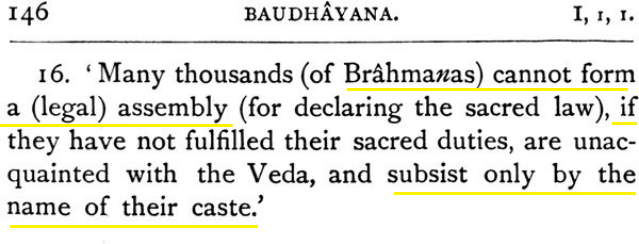
It should be a matter of pride that such noble principles were expounded by our forebears, who themselves embody how connected Andhra is with the rest of ancient Bharatavarsha. It should be a matter of pride for Andhras that 2 of the 4 sutrakaaraas of the 4 primary Dharmasutras hail from our lands. Nevertheless, as these great rishis themselves would write, arrogance and boastfulness is not a sign of culture.
So why try to phrase what the venerable Baudhayana muni himself wrote so many thousands of years ago. Regardless, of caste or class, this is what should define Telugu Culture today:
upadistho dharmah prathivedam | Thasyaanu vyaakhyasyaamah | smaartho dvitheeyah |trteeyah shisthaagamah | shisthaah khalu vigathamatsaraa nirahankaaraah kumbeedhaanyaa alolupaa dambha-darpa-lobha-moha-krodha-vivarjithaah || 1.1.1-6
“The law is taught in each Veda, in accordance with which we will explain it. What is given in the tradition is the second, and the conventions of cultured people are third.
Now, cultured people are those who are free from envy and pride, possess just a jarful of grain, and are free from covetousness, hypocrisy, arrogance, greed, folly, and anger.” [3, 197]
References:
- Kota,Venkatachalam Paakayaji (Pandit).Ancient Hindu History Part I.Vijayawada:AVG.
- Chitkara, M.G.Kashmir Shaivism: Under Siege. New Delhi: APH Publishing. 2002
- Olivelle, Patrick. Dharmasutras. Delhi: MLBD.2013
-
Buehler, Georg. The Sacred Laws of the Âryas. Delhi: MLBD. 2007
